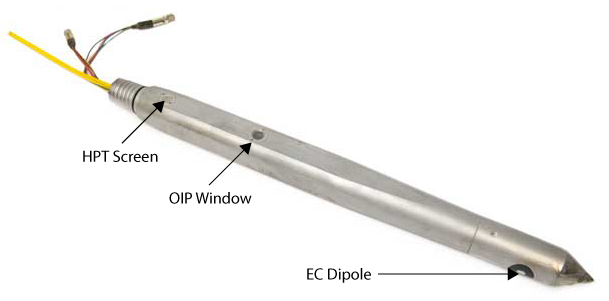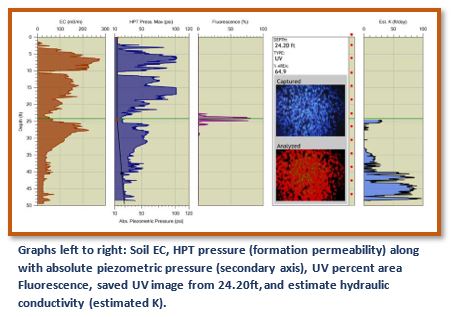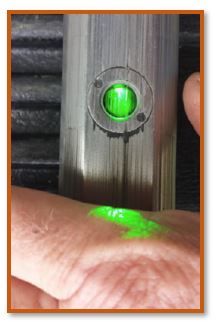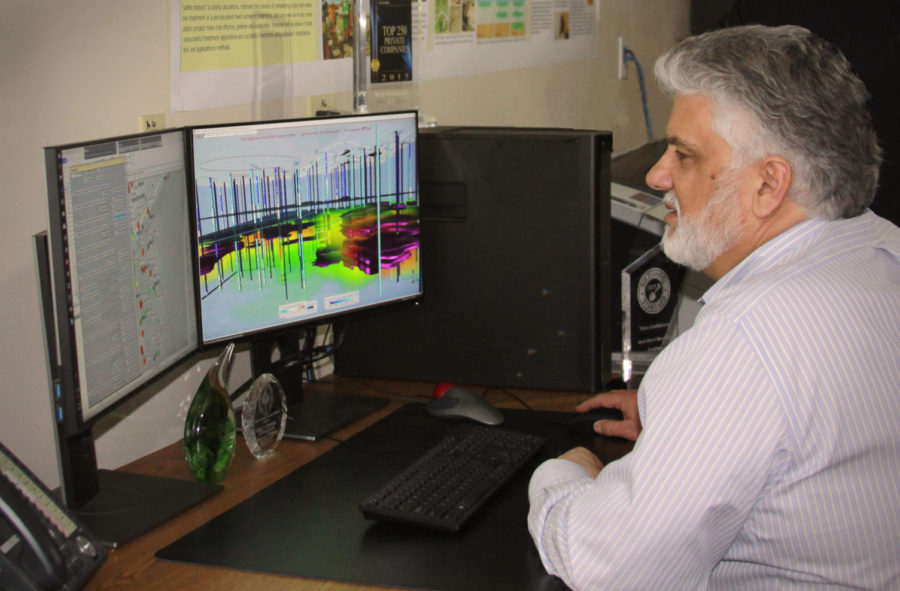OIP-UV Ultra-Violet
 The OIP-UV tool was developed in 2016 for the detection of petroleum LNAPL, such as fuels or crude oils, which will fluoresce when exposed to a 275nm UV light source in the tool. During the advancement of the probe, images of the soil are taken through a sapphire window in the probe with a CMOS camera. The image color is then analyzed by the software for presence of fluorescing light color consistent with that of known petroleum types. The fluorescence is measured as the percentage of fluorescent area in the image, or Percent Area Fluorescence (%AF). Most recently, this OIP-UV tool has been combined with the Hydraulic Profile Tool (HPT).
The OIP-UV tool was developed in 2016 for the detection of petroleum LNAPL, such as fuels or crude oils, which will fluoresce when exposed to a 275nm UV light source in the tool. During the advancement of the probe, images of the soil are taken through a sapphire window in the probe with a CMOS camera. The image color is then analyzed by the software for presence of fluorescing light color consistent with that of known petroleum types. The fluorescence is measured as the percentage of fluorescent area in the image, or Percent Area Fluorescence (%AF). Most recently, this OIP-UV tool has been combined with the Hydraulic Profile Tool (HPT).
OiHpt Combined OIP-UV and Hydraulic Profile Tool
 The new combination OiHpt tool captures LNAPL UV fluorescence (%AF) and visible light images, HPT injection pressure/flow, estimated K, and EC soilmeasurements. Previously, to map the permeability pathways that LNAPL could migrate within required offsetting the OIP borehole with the HPT tool to obtain the hydraulic conductivity data. Now, these tools are combined in one tool and also include electrical conductivity (EC), cutting acquisition time, and cost, in half.
The new combination OiHpt tool captures LNAPL UV fluorescence (%AF) and visible light images, HPT injection pressure/flow, estimated K, and EC soilmeasurements. Previously, to map the permeability pathways that LNAPL could migrate within required offsetting the OIP borehole with the HPT tool to obtain the hydraulic conductivity data. Now, these tools are combined in one tool and also include electrical conductivity (EC), cutting acquisition time, and cost, in half.
OIP-G Green Laser
 The new OIP-G Green Laser system is designed for identifying the fluorescence of heavier PAHs, such as creosote or coal tar, was also just released in 2018. Since heavier PAHs adsorb the shorter wavelength UV light, a longer wavelength excitation light is required, which causes stronger fluorescence of the PAHs in the yellow to red light wavelengths. An optical filter in the probe removes the shorter wavelengths interference, including the green light. This allows us to see these heavier NAPLS that can even be found as solids petroleum compounds (often DNAPLS). Soil texture can also be viewed by switching to the Infra-Red (IR) light source.
The new OIP-G Green Laser system is designed for identifying the fluorescence of heavier PAHs, such as creosote or coal tar, was also just released in 2018. Since heavier PAHs adsorb the shorter wavelength UV light, a longer wavelength excitation light is required, which causes stronger fluorescence of the PAHs in the yellow to red light wavelengths. An optical filter in the probe removes the shorter wavelengths interference, including the green light. This allows us to see these heavier NAPLS that can even be found as solids petroleum compounds (often DNAPLS). Soil texture can also be viewed by switching to the Infra-Red (IR) light source.




